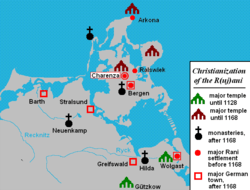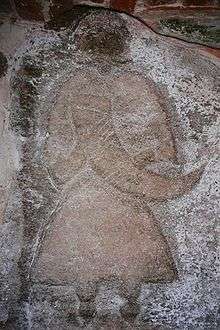Rani (Slavic tribe)
The Rani or Rujani (German: Ranen, Rujanen) were a West Slavic tribe based on the island of Rugia (Rügen) and the southwestern mainland across the Strelasund in what is today northeastern Germany.
Rani | |||||||||||
|---|---|---|---|---|---|---|---|---|---|---|---|
| 9th century–1168 | |||||||||||
 Christianization of the Rani; Slavic settlements, German towns with pagan temples and Christian monasteries | |||||||||||
| Status | Tribe of the Lutician federation | ||||||||||
| Capital | Arkona (seat of pagan high priests, political and religious centre) Charenza (princely seat and formal capital) | ||||||||||
| Common languages | Polabian language | ||||||||||
| Religion | Slavic paganism | ||||||||||
| Government | Virtual theocracy (formally, hereditary monarchy -- a principality) | ||||||||||
| Prince | |||||||||||
• c. 955 (first) | Vitzlav | ||||||||||
• c. 1170 (last) | Jaromar I | ||||||||||
| History | |||||||||||
• Formed | 9th century | ||||||||||
| 1168 | |||||||||||
| |||||||||||
| Today part of | |||||||||||
The Rani tribe emerged after the Slavic settlement of the region in the ninth century,[1] ranging among the most powerful of several small Slav tribes dwelling between the Elbe and lower Vistula rivers before the thirteenth century. They were amongst the last to cling to Slavic paganism, with the influence of their religious center at Arkona reaching far beyond the tribal borders.[2]
In 1168, the Rani were defeated by the Danish king, Valdemar I, and his adviser Absalon, Bishop of Roskilde, resulting in the conversion of the region to Christianity.[3][4][5][6] In the course of the Ostsiedlung of the thirteenth century, the tribe was assimilated by German and Danish settlers and the Rani were gradually Germanised. The Principality of Rugia remained Danish until 1325.[7][8]
Settlement
In the late migration period, areas which had previously been settled by Germanic tribes became settled by Slavs. In the case of Rugia and the adjacent mainland, where the Rugii were recorded before the migration period, Slavs first appeared in the ninth century;[1] continuous settlement from the pre-Slavic era is suggested based on pollen analyses and name transitions,[9] so a Rugian remnant seems to have been assimilated. The tribal name of the former inhabitants, the Rugii, might be the root of both the medieval name of Rugia and the tribal name of the Slavic R(uj)ani, though this hypothesis is not generally accepted.[10]
Religion

The Rani believed in multiple gods, all of which had several faces and were worshipped as tall wooden statues in their respective temples. They were worshipped in temples, holy groves, at home and in ritual meals. The mightiest among their gods was Svantevit, a four-headed god having his temple at Cape Arkona in the northernmost part of his isle of Wittow. This temple was worshipped and collected tributes not only from the Rani, but from all Baltic Wends after Rethra, which previously had been the main Wendish religious centre, was destroyed in a German raid in 1068/9.[11]
Other gods were Tjarnaglofi with his temple on Jasmund near today's Sagard, further there were Rugievit, Porevit and Porenut with temples in the capital, Charenza, and other gods with temples all over the Rani realm.
After the forced Christianization, monasteries and churches replaced the temples. In the church of Altenkirchen, a large stone from Arkona was used with a relief showing a Svantevit priest.
Administration and culture
Medieval chronicler Helmold of Bosau described the Rani as the only Wendish tribe ruled by a king and describes them as subduing many others while not tolerating subordinance themselves. Common decisions of the Wendish tribes were only made with the approval by the Rani. The mightiest position however was held by the High Priest called Drvovid, who stood above the king. The oracle decided if and where campaigns were mounted, and after a victory the monetary and noble metal part of the loot was given to the temple before the rest was partitioned. Subdued tribes were made subordinate to the temple.[11]
The Rani political capital was Charenza (then Korenitza, today an unsettled site called Venzer Burgwall). Rani dukes also resided at Rugard castle, a precursor of the modern city of Bergen. Throughout the Rani lands there were castles (burghs), all having a ring-like wall of wood and clay, protecting villages and/or religious sites, and functioned as strategic strongholds or seats of the gentry.
The Rani also established a main, mixed Slavic and Scandinavian trading center in Ralswiek. In the 11th and 12th centuries, they also raided their neighbors in a Viking manner.
Language
The Rani spoke a Polabian tongue, which belonged to the Lechitic group of the West Slavic languages. In the course of the 12th to 15th centuries, it was replaced by Low German as politics and ethnic structure had changed due to the Ostsiedlung. The Rani language became extinct when the last Rujani-speaking woman died on the Jasmund peninsula in 1404.[12]
History
In 955, Rani participated in the Battle of Recknitz, assisting German Otto I in defeating the Obotrites at the Recknitz (Raxa) River.
As the Obodrite state expanded in the late 11th century, the Rani were also pressed and in 1093 had to pay tribute to Obodrite prince Henry.[13] They launched a naval expedition in 1100, in the course of which they sieged Liubice, a predecessor of modern Lübeck and then the major Obodrite stronghold.[14] This attack was however repulsed.[14] In 1123, the Rani struck again and killed Henry's son Waldemar. When in 1123/24 an Obodrite army led by Henry reached the Rani territory, the Svantevit priests were forced to negotiate a peace.[14] Henry's army consisted of 2,000–6,000 men, devastated the coastal settlements, and the terms of the subsequent agreement were that the island would only be spared in return for an immense sum which had to be collected from the continental Slavs further east. Regrouping after Henry's death (1127), the Rani again assaulted and this time destroyed Liubice in 1128.[14] At this time they seem to have been devoted pagans, with their priests holding theocratic powers.
In 1136, the Danes defeated the Rani, who in turn had to promise to adopt Christian faith—yet returned to their pagan beliefs as the Danish headed back.[14]
A force of Rani attacked the Danish fleet during the 1147 Wendish Crusade. Saxon armies repeatedly managed to raid Rugia.
The Danes, who had assaulted the Rani already in 1136 and 1160, finally conquered the Rani stronghold of Arkona in 1168, forced the Slavs to become vassals of Denmark and to convert to Christianity.[14] The wooden statues of their gods were burned and monasteries and churches were built throughout the Rani lands.
The former Rani realm henceforth became the Danish Principality of Rugia.
List of rulers
Reported names of Rani tribal leaders ("kings" or "princes") were:
Sources
- Thompson, James Westfall (1928). Feudal Germany, Volume II. New York: Frederick Ungar Publishing.
- Herrmann, Joachim (1970). Die Slawen in Deutschland (in German). Berlin: Akademie-Verlag GmbH. p. 530.
See also
- List of Medieval Slavic tribes
Notes
- Ole Harck, Christian Lübke, Zwischen Reric und Bornhöved: Die Beziehungen zwischen den Dänen und ihren slawischen Nachbarn vom 9. Bis ins 13. Jahrhundert: Beiträge einer internationalen Konferenz, Leipzig, 4.-6. Dezember 1997, Franz Steiner Verlag, 2001, p.15, ISBN 3-515-07671-9
- Sebastian Brather, Archäologie der westlichen Slawen: Siedlung, Wirtschaft und Gesellschaft im früh- und hochmittelalterlichen Ostmitteleuropa, Walter de Gruyter, 2001, p.331, ISBN 3-11-017061-2
- Chisholm, Hugh, ed. (1911). . Encyclopædia Britannica (11th ed.). Cambridge University Press.
- Gerhard Krause, Horst Robert Balz, Gerhard Müller, Theologische Realenzyklopädie, Walter de Gruyter, 1997, pp.40ff, ISBN 3-11-015435-8
- Werner Buchholz, Pommern, Siedler, 1999, p.34, ISBN 3-88680-272-8
- Jan M Piskorski, Pommern im Wandel der Zeiten, 1999, p.43, ISBN 83-906184-8-6 OCLC 43087092
- Werner Buchholz, Pommern, Siedler, 1999, pp.46-52,pp.61-63 ISBN 3-88680-272-8
- Klaus Herbers, Nikolas Jaspert, Grenzräume und Grenzüberschreitungen im Vergleich: Der Osten und der Westen des mittelalterlichen Lateineuropa, 2007, pp. 76ff, ISBN 3-05-004155-2, ISBN 978-3-05-004155-1
- Joachim Herrmann, Die Slawen in Deutschland, Akademie-Verlag Berlin, 1985, p.27, pp.33ff
- Johannes Hoops, Hans-Peter Naumann, Franziska Lanter, Oliver Szokody, Heinrich Beck, Rudolf Simek, Sebastian Brather, Detlev Ellmers, Kurt Schier, Ulrike Sprenger, Else Ebel, Klaus Düwel, Wilhelm Heizmann, Heiko Uecker, Jürgen Udolph, Reallexikon der germanischen Altertumskunde, Walter de Gruyter, pp.419ff, ISBN 3-11-017733-1
- Kyra T. Inachin, Die Geschichte Pommerns, Hinstorff Rostock, 2008, p.14, ISBN 978-3-356-01044-2
- Werner Besch, Sprachgeschichte: Ein Handbuch zur Geschichte der deutschen Sprache und ihrer Erforschung2nd edition, Walter de Gruyter, 1998, p.2707, ISBN 3-11-015883-3
- Joachim Herrmann, Die Slawen in Deutschland, Akademie-Verlag Berlin, 1985, p.367
- Joachim Herrmann, Die Slawen in Deutschland, Akademie-Verlag Berlin, 1985, p.268